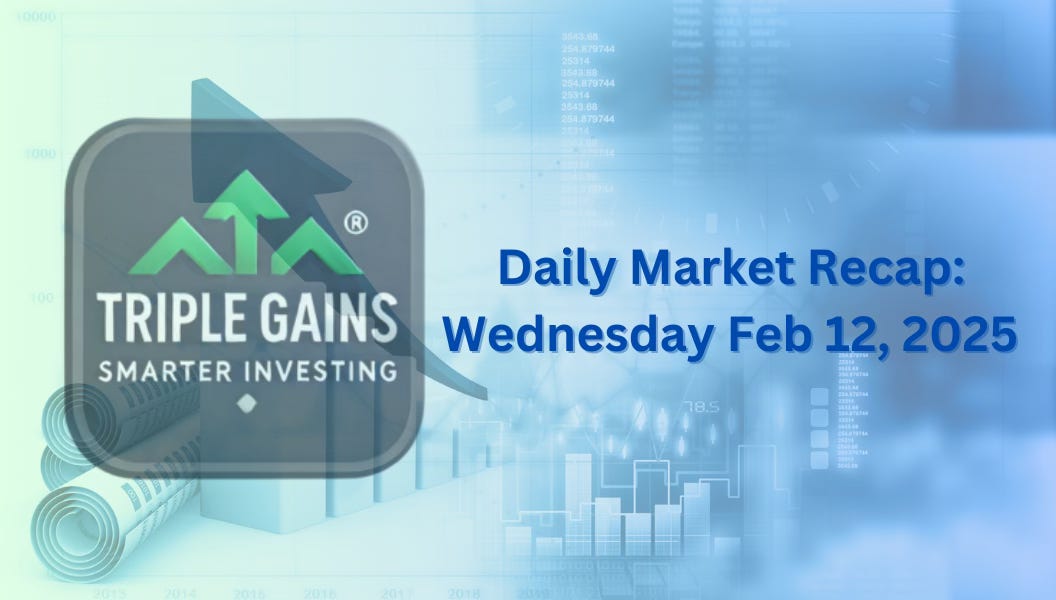Daily Market Recap – Wednesday Feb 12, 2025
Stocks Decline Amid Hot CPI Print and Hawkish Fed Expectations
US equities closed mostly lower on Wednesday as hotter-than-expected January CPI data fueled concerns over the Federal Reserve’s rate path. The S&P 500 (-0.27%) and Dow (-0.50%) declined, while the Nasdaq eked out a slight gain (+0.03%), and small caps underperformed with the Russell 2000 (-0.87%) leading losses. The hot inflation data led to a sharp rise in Treasury yields, particularly in the belly of the curve, with the 2-year yield jumping as traders repriced rate cut expectations further out into December from September.
Big tech was mixed, with TSLA-US stabilizing after its month-to-date selloff. Gainers included drug stores (CVS-US), managed care, legacy autos, biotech, China tech, casinos, and airlines, while homebuilders, home improvement, energy, trucking, ag chemicals, hospitals, and utilities were among the biggest underperformers. The dollar index fell 0.1%, reversing early strength, while gold edged down 0.1%. Bitcoin futures rose 2.1%, and WTI crude dropped 2.7% amid demand concerns.
CPI Report Fuels Rate Repricing and Hawkish Fed Outlook
January core CPI rose 0.4% m/m, hotter than the 0.3% expected, and the highest reading since April 2023. Headline CPI was up 0.5% m/m, also above expectations. On a yearly basis, core CPI ticked up to 3.3% (from 3.2%), while headline CPI came in at 3.0% (vs. 2.9% expected). Shelter costs—which account for nearly 30% of the monthly increase—jumped 0.4%, while used car prices also rebounded sharply, rising 2.2%. Other inflationary contributors included higher airline fares (+1.2%) and car insurance costs (+2.0%), while apparel prices fell (-1.4%), providing a slight offset.
Following the CPI release, markets pushed back rate cut expectations, with the first Fed cut now priced for December, compared to September before the report. The move was reinforced by Fed Chair Powell’s testimony, where he noted that the Fed still has more work to do on inflation. Atlanta Fed President Bostic echoed this sentiment, saying the Fed will hold rates steady until there is more clarity, while Chicago Fed's Goolsbee warned that if inflation remains strong for multiple months, the Fed’s job on inflation is clearly not done.
Earnings Highlights
Earnings results were mixed, with CVS-US surging on a strong Q4 beat, while GILD-US (HIV business strength) and EW-US (TAVR, TMTT growth) posted solid gains. DASH-US (DoorDash) beat on GOV and EBITDA, while SMCI-US rebounded on upbeat 2026 guidance. UPST-US soared 31.8% after reporting stronger-than-expected volume growth and positive guidance, prompting multiple analyst upgrades.
On the downside, STAA-US collapsed 24.7% after calling out China softness, while TDC-US (-20.3%) slumped on weak cloud ARR and a disappointing FY25 guide. BL-US (-18.1%) fell sharply on weak guidance and macro-related deal slippage, and LYFT-US (-7.9%) declined after weak bookings amid pricing pressure.
Other Notable Developments
House Speaker Johnson signaled that the Trump administration may consider reciprocal tariff exemptions for autos and pharma, boosting GM-US (+2.1%) and F-US.
NEC’s Hassett said Trump’s reciprocal tariff details are still in progress, with an announcement expected as soon as tomorrow.
Chevron (CVX-US) announced plans to cut up to 20% of its workforce by next year as part of a cost-saving initiative.
GM and Ford saw gains as reports suggested potential exemptions for auto tariffs.
Intel (INTC-US) rose after VP Vance stated the White House will ensure the most powerful AI systems are built in the US with American-made chips.
Investment Takeaways
Today’s hot CPI print reaffirmed that inflation remains a headwind, delaying Fed rate cut expectations to December and pushing Treasury yields higher. The stronger-than-expected inflation data introduces risk to equity markets, particularly rate-sensitive sectors like housing, utilities, and REITs. However, AI and tech stocks showed resilience, with semiconductor and cloud-related companies benefiting from long-term demand drivers. Earnings season has been a mixed bag, but AI-related capex and margin expansion remain key themes. We will continue to monitor Trump’s reciprocal tariff announcements, upcoming PPI data, and Fed rhetoric for further clarity on inflation, trade policy, and rate expectations.



